Effective Professional Communication in Nursing for Optimal Outcomes
VerifiedAdded on 2023/06/13
|8
|1941
|169
Essay
AI Summary
This essay delves into the critical role of professional communication in nursing, emphasizing its significance in fostering therapeutic relationships between nurses and patients. It highlights how effective communication contributes to patient-centered care, enabling nurses to understand and address patients' individual needs and preferences. The essay also explores the importance of accurate and thorough documentation as a vital communication tool within the healthcare team, ensuring continuity of care and serving as a legal record. Using a case study of a 63-year-old male patient, the essay illustrates how nurses can apply communication techniques to promote holistic care and achieve optimal patient outcomes. The conclusion reinforces that professional communication is a non-negotiable right and a requirement for developing a bona fide relation between the nurses and the patients.
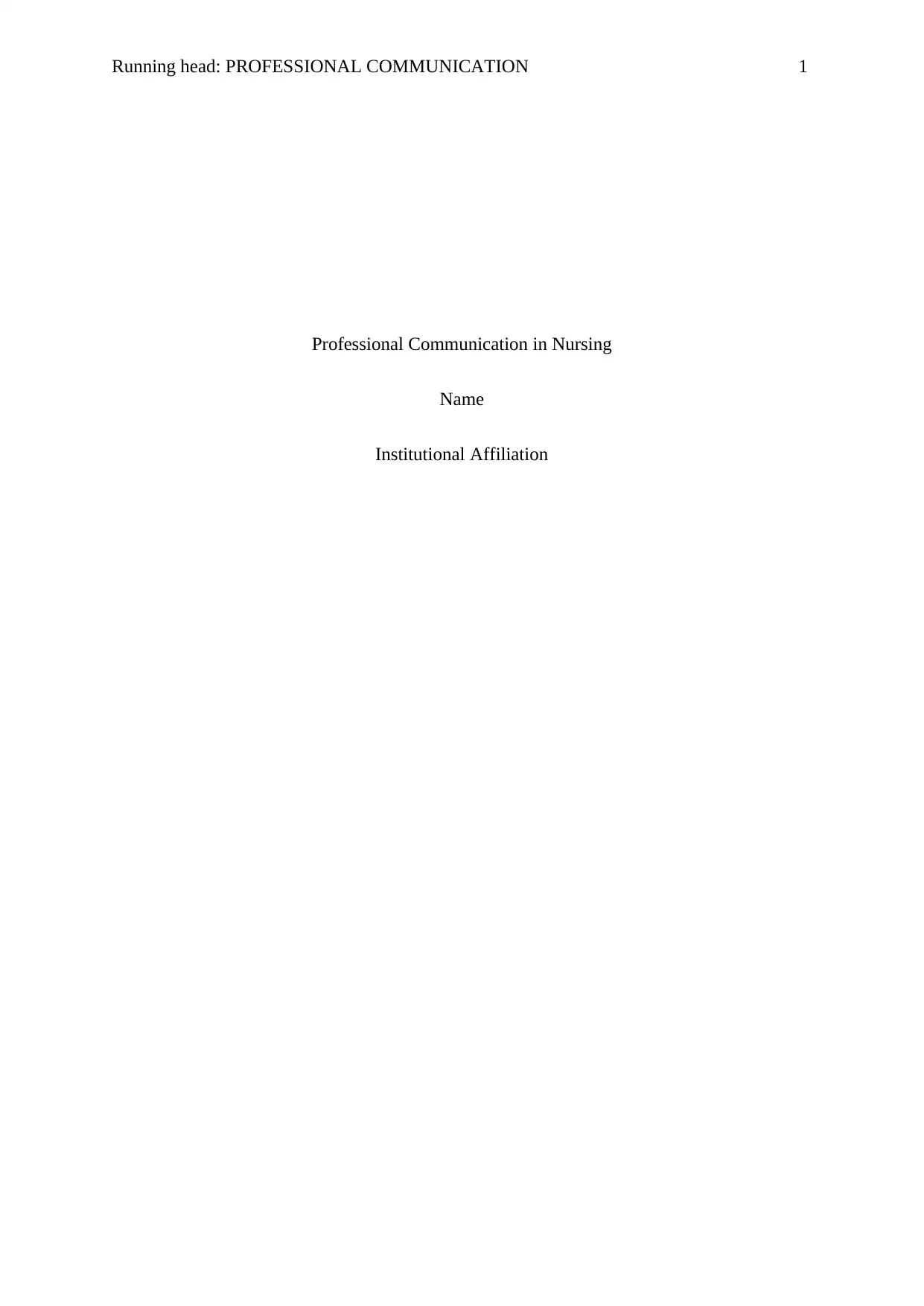
Running head: PROFESSIONAL COMMUNICATION 1
Professional Communication in Nursing
Name
Institutional Affiliation
Professional Communication in Nursing
Name
Institutional Affiliation
Paraphrase This Document
Need a fresh take? Get an instant paraphrase of this document with our AI Paraphraser
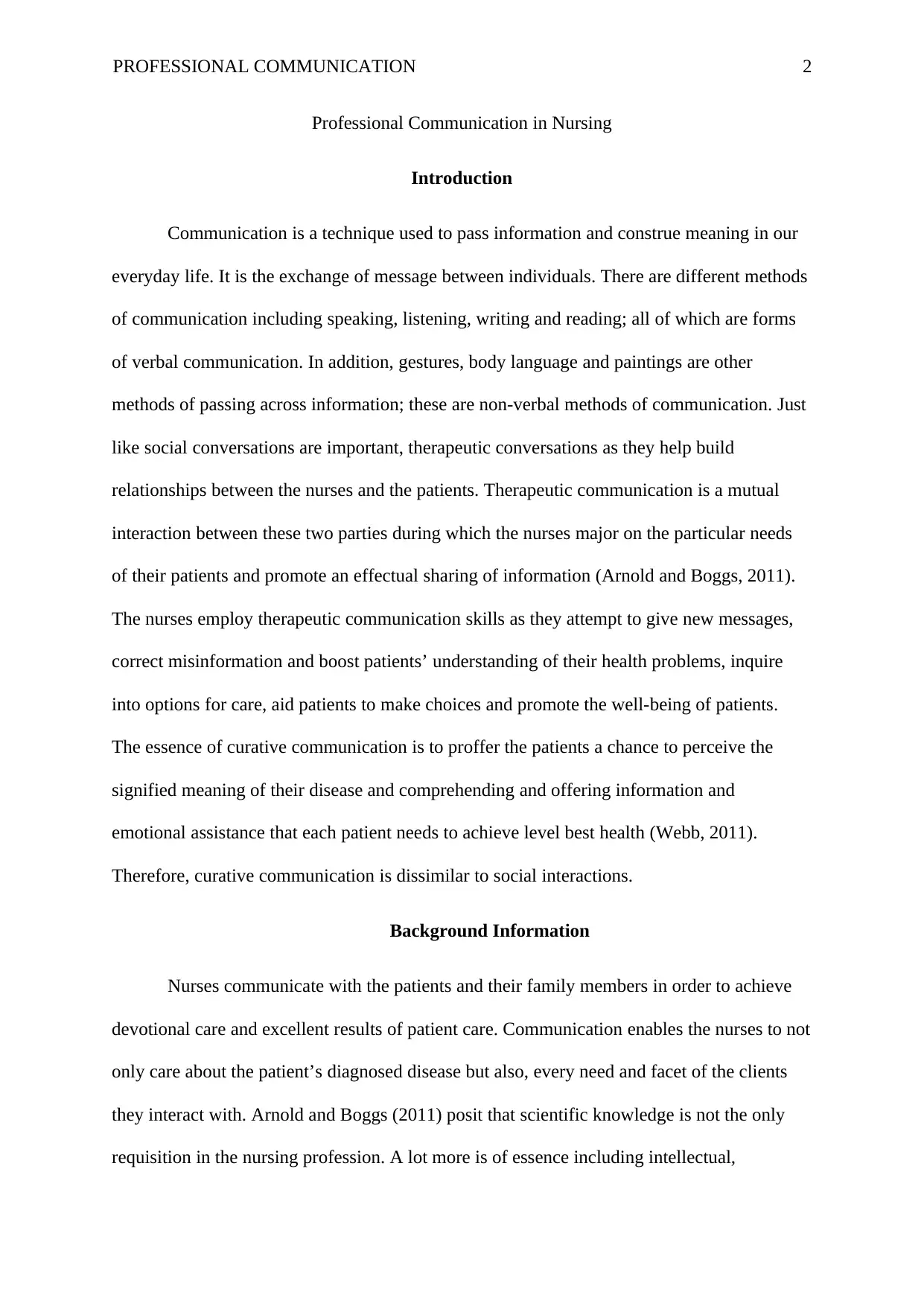
PROFESSIONAL COMMUNICATION 2
Professional Communication in Nursing
Introduction
Communication is a technique used to pass information and construe meaning in our
everyday life. It is the exchange of message between individuals. There are different methods
of communication including speaking, listening, writing and reading; all of which are forms
of verbal communication. In addition, gestures, body language and paintings are other
methods of passing across information; these are non-verbal methods of communication. Just
like social conversations are important, therapeutic conversations as they help build
relationships between the nurses and the patients. Therapeutic communication is a mutual
interaction between these two parties during which the nurses major on the particular needs
of their patients and promote an effectual sharing of information (Arnold and Boggs, 2011).
The nurses employ therapeutic communication skills as they attempt to give new messages,
correct misinformation and boost patients’ understanding of their health problems, inquire
into options for care, aid patients to make choices and promote the well-being of patients.
The essence of curative communication is to proffer the patients a chance to perceive the
signified meaning of their disease and comprehending and offering information and
emotional assistance that each patient needs to achieve level best health (Webb, 2011).
Therefore, curative communication is dissimilar to social interactions.
Background Information
Nurses communicate with the patients and their family members in order to achieve
devotional care and excellent results of patient care. Communication enables the nurses to not
only care about the patient’s diagnosed disease but also, every need and facet of the clients
they interact with. Arnold and Boggs (2011) posit that scientific knowledge is not the only
requisition in the nursing profession. A lot more is of essence including intellectual,
Professional Communication in Nursing
Introduction
Communication is a technique used to pass information and construe meaning in our
everyday life. It is the exchange of message between individuals. There are different methods
of communication including speaking, listening, writing and reading; all of which are forms
of verbal communication. In addition, gestures, body language and paintings are other
methods of passing across information; these are non-verbal methods of communication. Just
like social conversations are important, therapeutic conversations as they help build
relationships between the nurses and the patients. Therapeutic communication is a mutual
interaction between these two parties during which the nurses major on the particular needs
of their patients and promote an effectual sharing of information (Arnold and Boggs, 2011).
The nurses employ therapeutic communication skills as they attempt to give new messages,
correct misinformation and boost patients’ understanding of their health problems, inquire
into options for care, aid patients to make choices and promote the well-being of patients.
The essence of curative communication is to proffer the patients a chance to perceive the
signified meaning of their disease and comprehending and offering information and
emotional assistance that each patient needs to achieve level best health (Webb, 2011).
Therefore, curative communication is dissimilar to social interactions.
Background Information
Nurses communicate with the patients and their family members in order to achieve
devotional care and excellent results of patient care. Communication enables the nurses to not
only care about the patient’s diagnosed disease but also, every need and facet of the clients
they interact with. Arnold and Boggs (2011) posit that scientific knowledge is not the only
requisition in the nursing profession. A lot more is of essence including intellectual,
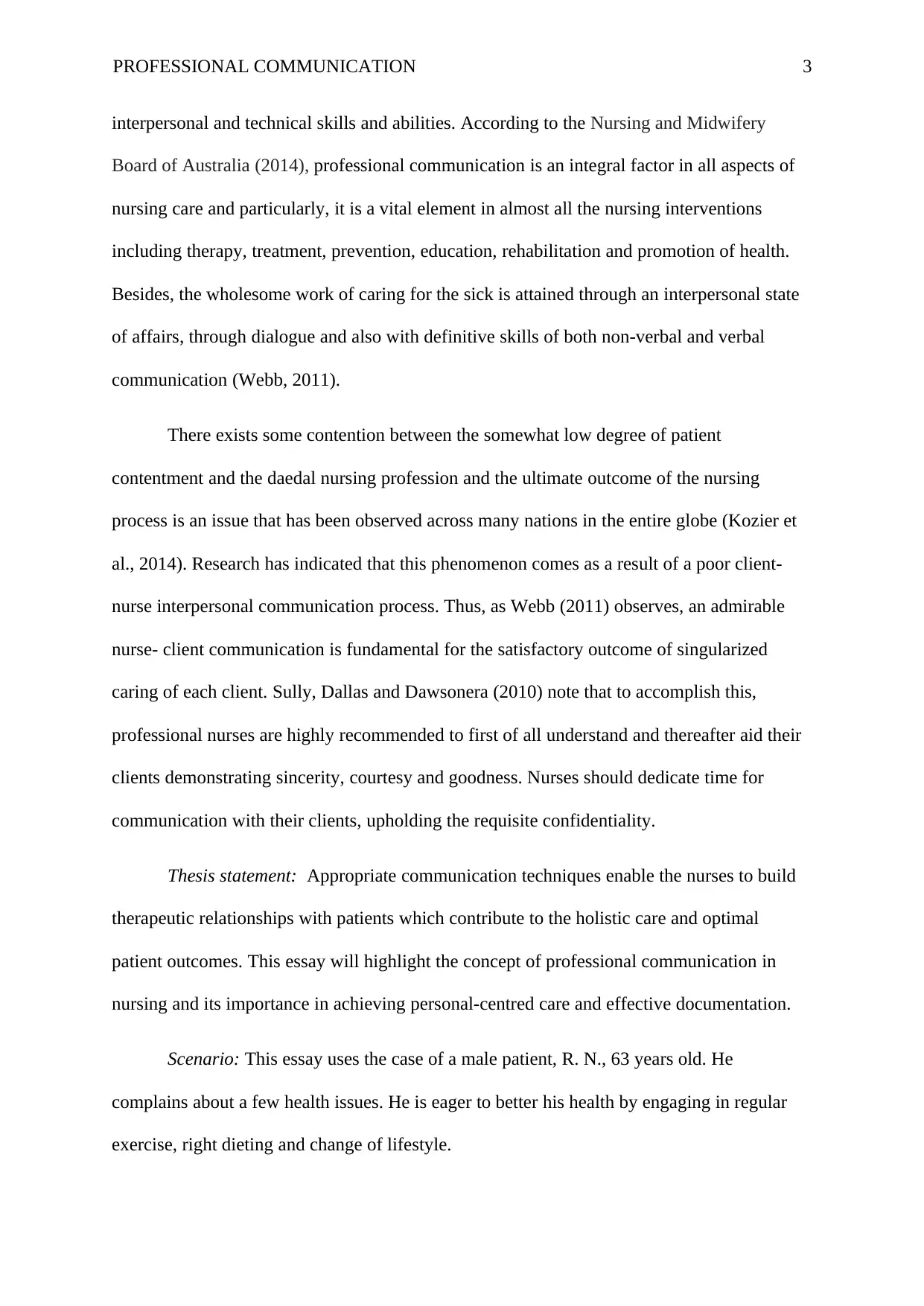
PROFESSIONAL COMMUNICATION 3
interpersonal and technical skills and abilities. According to the Nursing and Midwifery
Board of Australia (2014), professional communication is an integral factor in all aspects of
nursing care and particularly, it is a vital element in almost all the nursing interventions
including therapy, treatment, prevention, education, rehabilitation and promotion of health.
Besides, the wholesome work of caring for the sick is attained through an interpersonal state
of affairs, through dialogue and also with definitive skills of both non-verbal and verbal
communication (Webb, 2011).
There exists some contention between the somewhat low degree of patient
contentment and the daedal nursing profession and the ultimate outcome of the nursing
process is an issue that has been observed across many nations in the entire globe (Kozier et
al., 2014). Research has indicated that this phenomenon comes as a result of a poor client-
nurse interpersonal communication process. Thus, as Webb (2011) observes, an admirable
nurse- client communication is fundamental for the satisfactory outcome of singularized
caring of each client. Sully, Dallas and Dawsonera (2010) note that to accomplish this,
professional nurses are highly recommended to first of all understand and thereafter aid their
clients demonstrating sincerity, courtesy and goodness. Nurses should dedicate time for
communication with their clients, upholding the requisite confidentiality.
Thesis statement: Appropriate communication techniques enable the nurses to build
therapeutic relationships with patients which contribute to the holistic care and optimal
patient outcomes. This essay will highlight the concept of professional communication in
nursing and its importance in achieving personal-centred care and effective documentation.
Scenario: This essay uses the case of a male patient, R. N., 63 years old. He
complains about a few health issues. He is eager to better his health by engaging in regular
exercise, right dieting and change of lifestyle.
interpersonal and technical skills and abilities. According to the Nursing and Midwifery
Board of Australia (2014), professional communication is an integral factor in all aspects of
nursing care and particularly, it is a vital element in almost all the nursing interventions
including therapy, treatment, prevention, education, rehabilitation and promotion of health.
Besides, the wholesome work of caring for the sick is attained through an interpersonal state
of affairs, through dialogue and also with definitive skills of both non-verbal and verbal
communication (Webb, 2011).
There exists some contention between the somewhat low degree of patient
contentment and the daedal nursing profession and the ultimate outcome of the nursing
process is an issue that has been observed across many nations in the entire globe (Kozier et
al., 2014). Research has indicated that this phenomenon comes as a result of a poor client-
nurse interpersonal communication process. Thus, as Webb (2011) observes, an admirable
nurse- client communication is fundamental for the satisfactory outcome of singularized
caring of each client. Sully, Dallas and Dawsonera (2010) note that to accomplish this,
professional nurses are highly recommended to first of all understand and thereafter aid their
clients demonstrating sincerity, courtesy and goodness. Nurses should dedicate time for
communication with their clients, upholding the requisite confidentiality.
Thesis statement: Appropriate communication techniques enable the nurses to build
therapeutic relationships with patients which contribute to the holistic care and optimal
patient outcomes. This essay will highlight the concept of professional communication in
nursing and its importance in achieving personal-centred care and effective documentation.
Scenario: This essay uses the case of a male patient, R. N., 63 years old. He
complains about a few health issues. He is eager to better his health by engaging in regular
exercise, right dieting and change of lifestyle.
⊘ This is a preview!⊘
Do you want full access?
Subscribe today to unlock all pages.

Trusted by 1+ million students worldwide
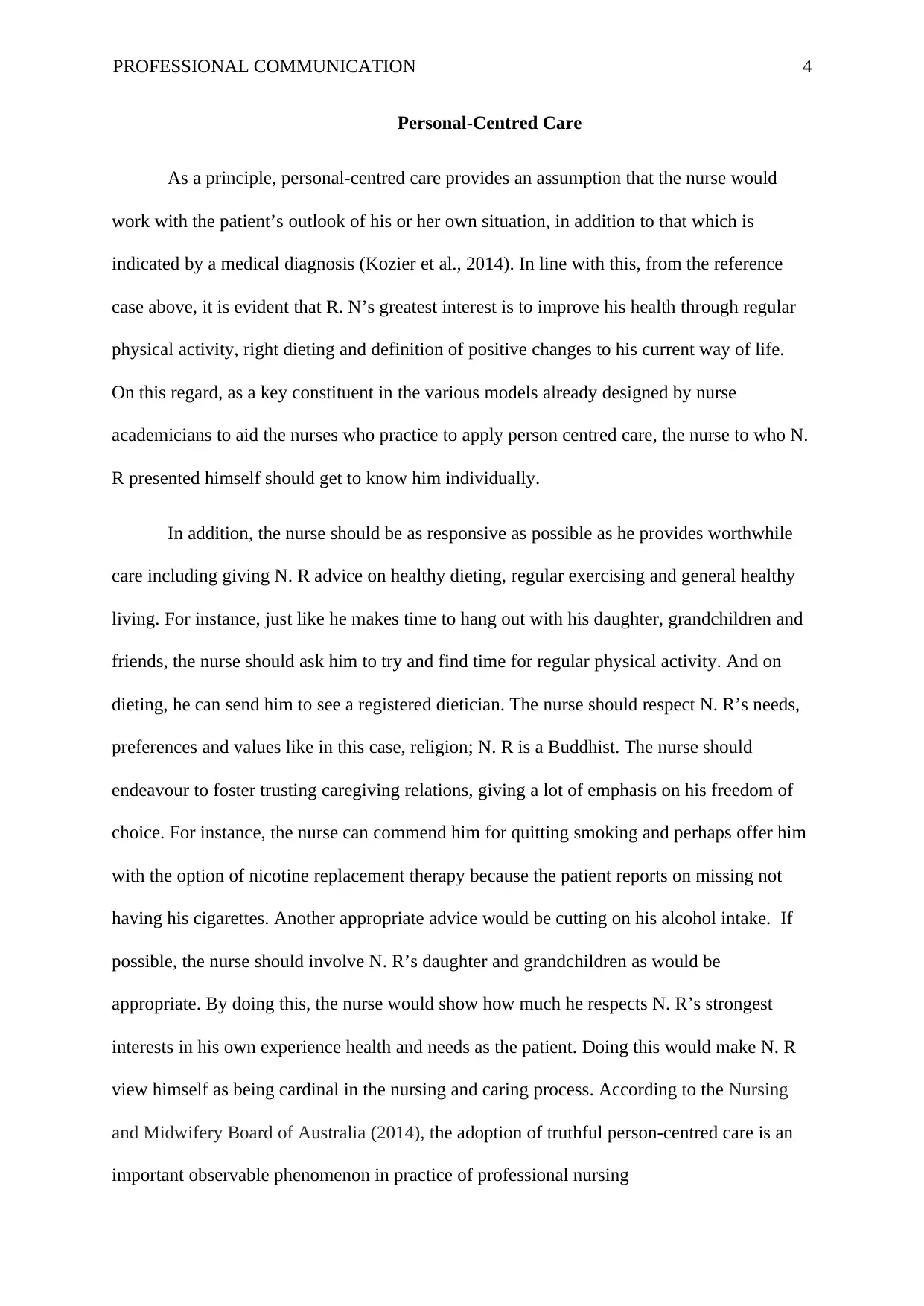
PROFESSIONAL COMMUNICATION 4
Personal-Centred Care
As a principle, personal-centred care provides an assumption that the nurse would
work with the patient’s outlook of his or her own situation, in addition to that which is
indicated by a medical diagnosis (Kozier et al., 2014). In line with this, from the reference
case above, it is evident that R. N’s greatest interest is to improve his health through regular
physical activity, right dieting and definition of positive changes to his current way of life.
On this regard, as a key constituent in the various models already designed by nurse
academicians to aid the nurses who practice to apply person centred care, the nurse to who N.
R presented himself should get to know him individually.
In addition, the nurse should be as responsive as possible as he provides worthwhile
care including giving N. R advice on healthy dieting, regular exercising and general healthy
living. For instance, just like he makes time to hang out with his daughter, grandchildren and
friends, the nurse should ask him to try and find time for regular physical activity. And on
dieting, he can send him to see a registered dietician. The nurse should respect N. R’s needs,
preferences and values like in this case, religion; N. R is a Buddhist. The nurse should
endeavour to foster trusting caregiving relations, giving a lot of emphasis on his freedom of
choice. For instance, the nurse can commend him for quitting smoking and perhaps offer him
with the option of nicotine replacement therapy because the patient reports on missing not
having his cigarettes. Another appropriate advice would be cutting on his alcohol intake. If
possible, the nurse should involve N. R’s daughter and grandchildren as would be
appropriate. By doing this, the nurse would show how much he respects N. R’s strongest
interests in his own experience health and needs as the patient. Doing this would make N. R
view himself as being cardinal in the nursing and caring process. According to the Nursing
and Midwifery Board of Australia (2014), the adoption of truthful person-centred care is an
important observable phenomenon in practice of professional nursing
Personal-Centred Care
As a principle, personal-centred care provides an assumption that the nurse would
work with the patient’s outlook of his or her own situation, in addition to that which is
indicated by a medical diagnosis (Kozier et al., 2014). In line with this, from the reference
case above, it is evident that R. N’s greatest interest is to improve his health through regular
physical activity, right dieting and definition of positive changes to his current way of life.
On this regard, as a key constituent in the various models already designed by nurse
academicians to aid the nurses who practice to apply person centred care, the nurse to who N.
R presented himself should get to know him individually.
In addition, the nurse should be as responsive as possible as he provides worthwhile
care including giving N. R advice on healthy dieting, regular exercising and general healthy
living. For instance, just like he makes time to hang out with his daughter, grandchildren and
friends, the nurse should ask him to try and find time for regular physical activity. And on
dieting, he can send him to see a registered dietician. The nurse should respect N. R’s needs,
preferences and values like in this case, religion; N. R is a Buddhist. The nurse should
endeavour to foster trusting caregiving relations, giving a lot of emphasis on his freedom of
choice. For instance, the nurse can commend him for quitting smoking and perhaps offer him
with the option of nicotine replacement therapy because the patient reports on missing not
having his cigarettes. Another appropriate advice would be cutting on his alcohol intake. If
possible, the nurse should involve N. R’s daughter and grandchildren as would be
appropriate. By doing this, the nurse would show how much he respects N. R’s strongest
interests in his own experience health and needs as the patient. Doing this would make N. R
view himself as being cardinal in the nursing and caring process. According to the Nursing
and Midwifery Board of Australia (2014), the adoption of truthful person-centred care is an
important observable phenomenon in practice of professional nursing
Paraphrase This Document
Need a fresh take? Get an instant paraphrase of this document with our AI Paraphraser
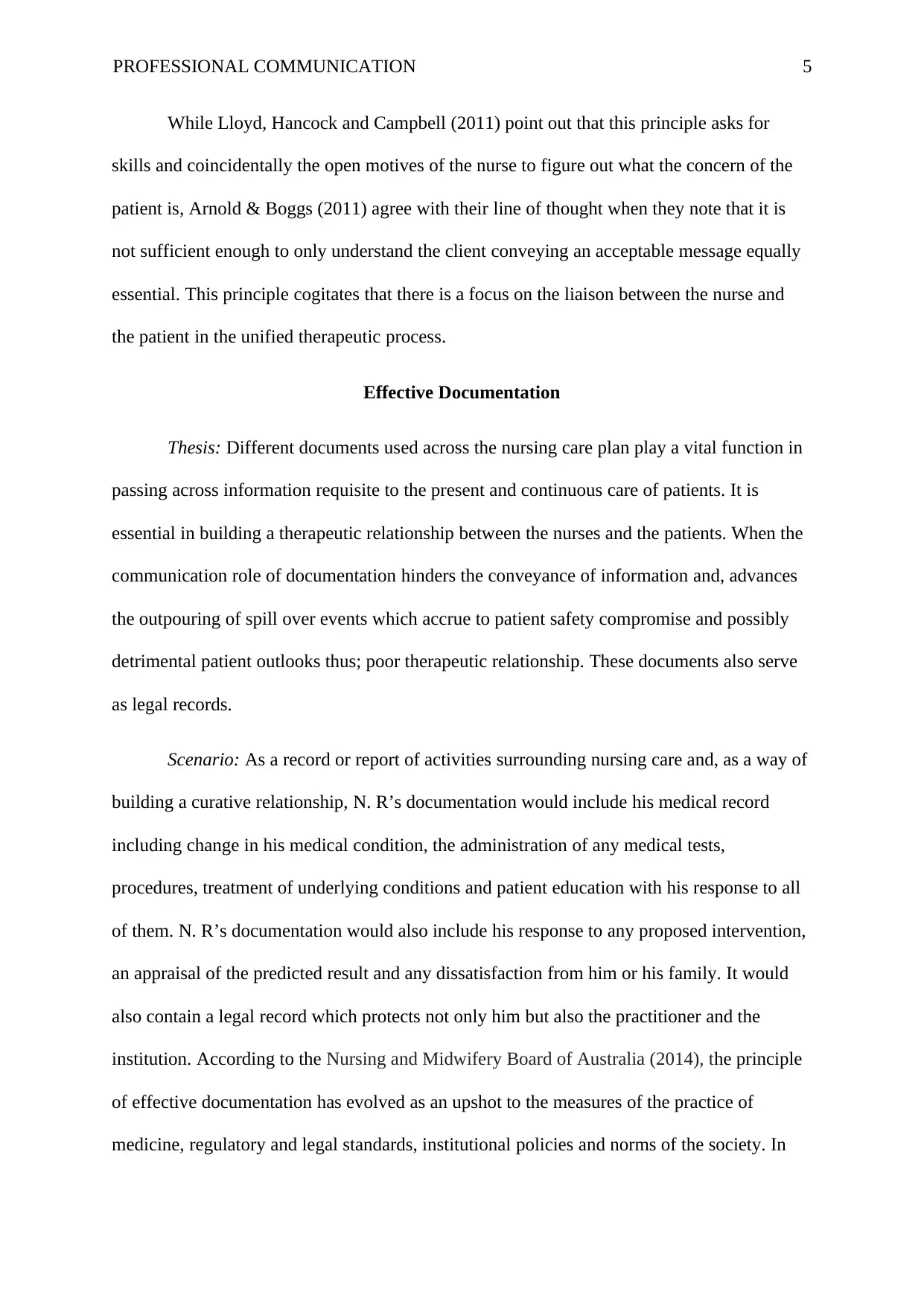
PROFESSIONAL COMMUNICATION 5
While Lloyd, Hancock and Campbell (2011) point out that this principle asks for
skills and coincidentally the open motives of the nurse to figure out what the concern of the
patient is, Arnold & Boggs (2011) agree with their line of thought when they note that it is
not sufficient enough to only understand the client conveying an acceptable message equally
essential. This principle cogitates that there is a focus on the liaison between the nurse and
the patient in the unified therapeutic process.
Effective Documentation
Thesis: Different documents used across the nursing care plan play a vital function in
passing across information requisite to the present and continuous care of patients. It is
essential in building a therapeutic relationship between the nurses and the patients. When the
communication role of documentation hinders the conveyance of information and, advances
the outpouring of spill over events which accrue to patient safety compromise and possibly
detrimental patient outlooks thus; poor therapeutic relationship. These documents also serve
as legal records.
Scenario: As a record or report of activities surrounding nursing care and, as a way of
building a curative relationship, N. R’s documentation would include his medical record
including change in his medical condition, the administration of any medical tests,
procedures, treatment of underlying conditions and patient education with his response to all
of them. N. R’s documentation would also include his response to any proposed intervention,
an appraisal of the predicted result and any dissatisfaction from him or his family. It would
also contain a legal record which protects not only him but also the practitioner and the
institution. According to the Nursing and Midwifery Board of Australia (2014), the principle
of effective documentation has evolved as an upshot to the measures of the practice of
medicine, regulatory and legal standards, institutional policies and norms of the society. In
While Lloyd, Hancock and Campbell (2011) point out that this principle asks for
skills and coincidentally the open motives of the nurse to figure out what the concern of the
patient is, Arnold & Boggs (2011) agree with their line of thought when they note that it is
not sufficient enough to only understand the client conveying an acceptable message equally
essential. This principle cogitates that there is a focus on the liaison between the nurse and
the patient in the unified therapeutic process.
Effective Documentation
Thesis: Different documents used across the nursing care plan play a vital function in
passing across information requisite to the present and continuous care of patients. It is
essential in building a therapeutic relationship between the nurses and the patients. When the
communication role of documentation hinders the conveyance of information and, advances
the outpouring of spill over events which accrue to patient safety compromise and possibly
detrimental patient outlooks thus; poor therapeutic relationship. These documents also serve
as legal records.
Scenario: As a record or report of activities surrounding nursing care and, as a way of
building a curative relationship, N. R’s documentation would include his medical record
including change in his medical condition, the administration of any medical tests,
procedures, treatment of underlying conditions and patient education with his response to all
of them. N. R’s documentation would also include his response to any proposed intervention,
an appraisal of the predicted result and any dissatisfaction from him or his family. It would
also contain a legal record which protects not only him but also the practitioner and the
institution. According to the Nursing and Midwifery Board of Australia (2014), the principle
of effective documentation has evolved as an upshot to the measures of the practice of
medicine, regulatory and legal standards, institutional policies and norms of the society. In
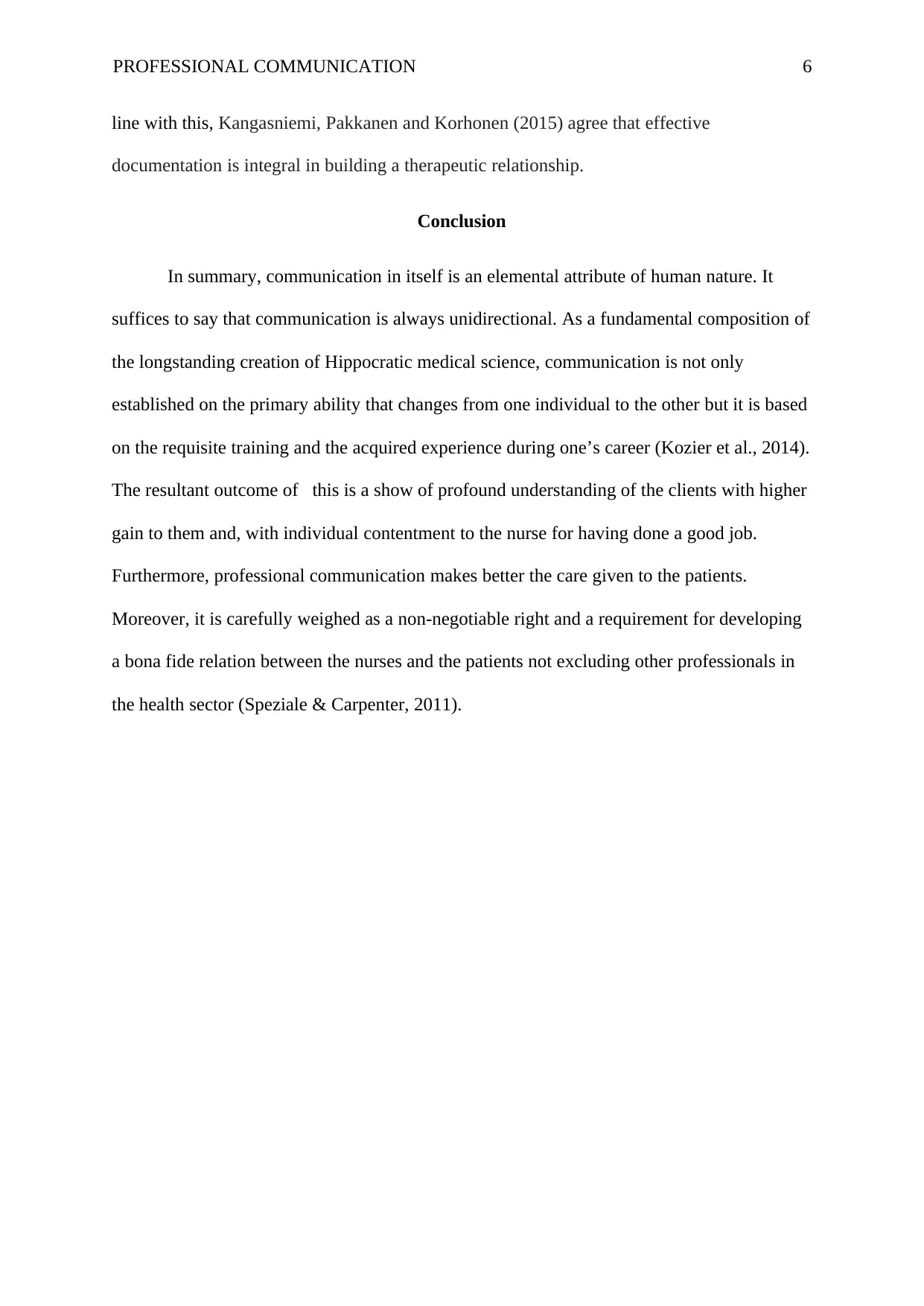
PROFESSIONAL COMMUNICATION 6
line with this, Kangasniemi, Pakkanen and Korhonen (2015) agree that effective
documentation is integral in building a therapeutic relationship.
Conclusion
In summary, communication in itself is an elemental attribute of human nature. It
suffices to say that communication is always unidirectional. As a fundamental composition of
the longstanding creation of Hippocratic medical science, communication is not only
established on the primary ability that changes from one individual to the other but it is based
on the requisite training and the acquired experience during one’s career (Kozier et al., 2014).
The resultant outcome of this is a show of profound understanding of the clients with higher
gain to them and, with individual contentment to the nurse for having done a good job.
Furthermore, professional communication makes better the care given to the patients.
Moreover, it is carefully weighed as a non-negotiable right and a requirement for developing
a bona fide relation between the nurses and the patients not excluding other professionals in
the health sector (Speziale & Carpenter, 2011).
line with this, Kangasniemi, Pakkanen and Korhonen (2015) agree that effective
documentation is integral in building a therapeutic relationship.
Conclusion
In summary, communication in itself is an elemental attribute of human nature. It
suffices to say that communication is always unidirectional. As a fundamental composition of
the longstanding creation of Hippocratic medical science, communication is not only
established on the primary ability that changes from one individual to the other but it is based
on the requisite training and the acquired experience during one’s career (Kozier et al., 2014).
The resultant outcome of this is a show of profound understanding of the clients with higher
gain to them and, with individual contentment to the nurse for having done a good job.
Furthermore, professional communication makes better the care given to the patients.
Moreover, it is carefully weighed as a non-negotiable right and a requirement for developing
a bona fide relation between the nurses and the patients not excluding other professionals in
the health sector (Speziale & Carpenter, 2011).
⊘ This is a preview!⊘
Do you want full access?
Subscribe today to unlock all pages.

Trusted by 1+ million students worldwide
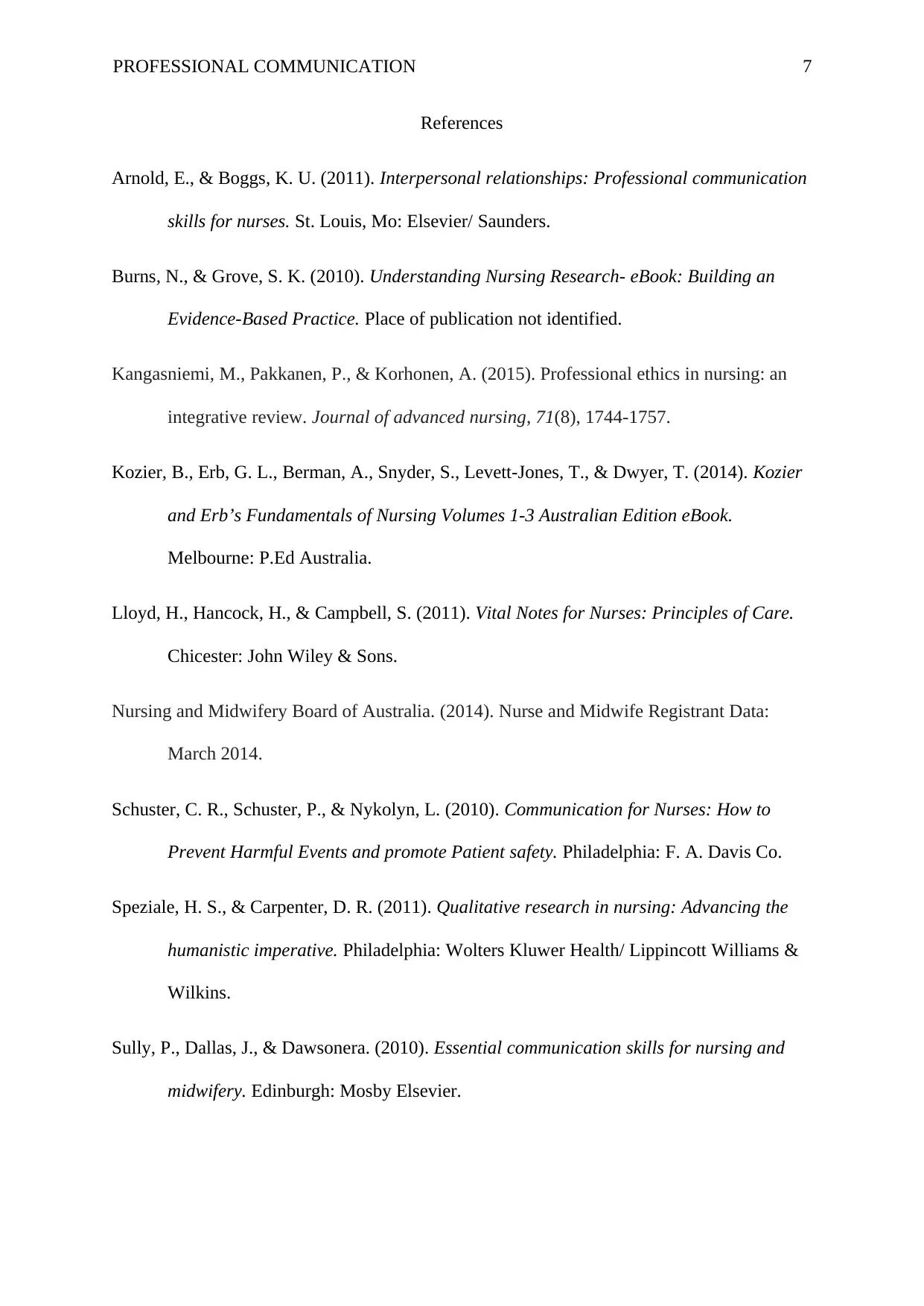
PROFESSIONAL COMMUNICATION 7
References
Arnold, E., & Boggs, K. U. (2011). Interpersonal relationships: Professional communication
skills for nurses. St. Louis, Mo: Elsevier/ Saunders.
Burns, N., & Grove, S. K. (2010). Understanding Nursing Research- eBook: Building an
Evidence-Based Practice. Place of publication not identified.
Kangasniemi, M., Pakkanen, P., & Korhonen, A. (2015). Professional ethics in nursing: an
integrative review. Journal of advanced nursing, 71(8), 1744-1757.
Kozier, B., Erb, G. L., Berman, A., Snyder, S., Levett-Jones, T., & Dwyer, T. (2014). Kozier
and Erb’s Fundamentals of Nursing Volumes 1-3 Australian Edition eBook.
Melbourne: P.Ed Australia.
Lloyd, H., Hancock, H., & Campbell, S. (2011). Vital Notes for Nurses: Principles of Care.
Chicester: John Wiley & Sons.
Nursing and Midwifery Board of Australia. (2014). Nurse and Midwife Registrant Data:
March 2014.
Schuster, C. R., Schuster, P., & Nykolyn, L. (2010). Communication for Nurses: How to
Prevent Harmful Events and promote Patient safety. Philadelphia: F. A. Davis Co.
Speziale, H. S., & Carpenter, D. R. (2011). Qualitative research in nursing: Advancing the
humanistic imperative. Philadelphia: Wolters Kluwer Health/ Lippincott Williams &
Wilkins.
Sully, P., Dallas, J., & Dawsonera. (2010). Essential communication skills for nursing and
midwifery. Edinburgh: Mosby Elsevier.
References
Arnold, E., & Boggs, K. U. (2011). Interpersonal relationships: Professional communication
skills for nurses. St. Louis, Mo: Elsevier/ Saunders.
Burns, N., & Grove, S. K. (2010). Understanding Nursing Research- eBook: Building an
Evidence-Based Practice. Place of publication not identified.
Kangasniemi, M., Pakkanen, P., & Korhonen, A. (2015). Professional ethics in nursing: an
integrative review. Journal of advanced nursing, 71(8), 1744-1757.
Kozier, B., Erb, G. L., Berman, A., Snyder, S., Levett-Jones, T., & Dwyer, T. (2014). Kozier
and Erb’s Fundamentals of Nursing Volumes 1-3 Australian Edition eBook.
Melbourne: P.Ed Australia.
Lloyd, H., Hancock, H., & Campbell, S. (2011). Vital Notes for Nurses: Principles of Care.
Chicester: John Wiley & Sons.
Nursing and Midwifery Board of Australia. (2014). Nurse and Midwife Registrant Data:
March 2014.
Schuster, C. R., Schuster, P., & Nykolyn, L. (2010). Communication for Nurses: How to
Prevent Harmful Events and promote Patient safety. Philadelphia: F. A. Davis Co.
Speziale, H. S., & Carpenter, D. R. (2011). Qualitative research in nursing: Advancing the
humanistic imperative. Philadelphia: Wolters Kluwer Health/ Lippincott Williams &
Wilkins.
Sully, P., Dallas, J., & Dawsonera. (2010). Essential communication skills for nursing and
midwifery. Edinburgh: Mosby Elsevier.
Paraphrase This Document
Need a fresh take? Get an instant paraphrase of this document with our AI Paraphraser
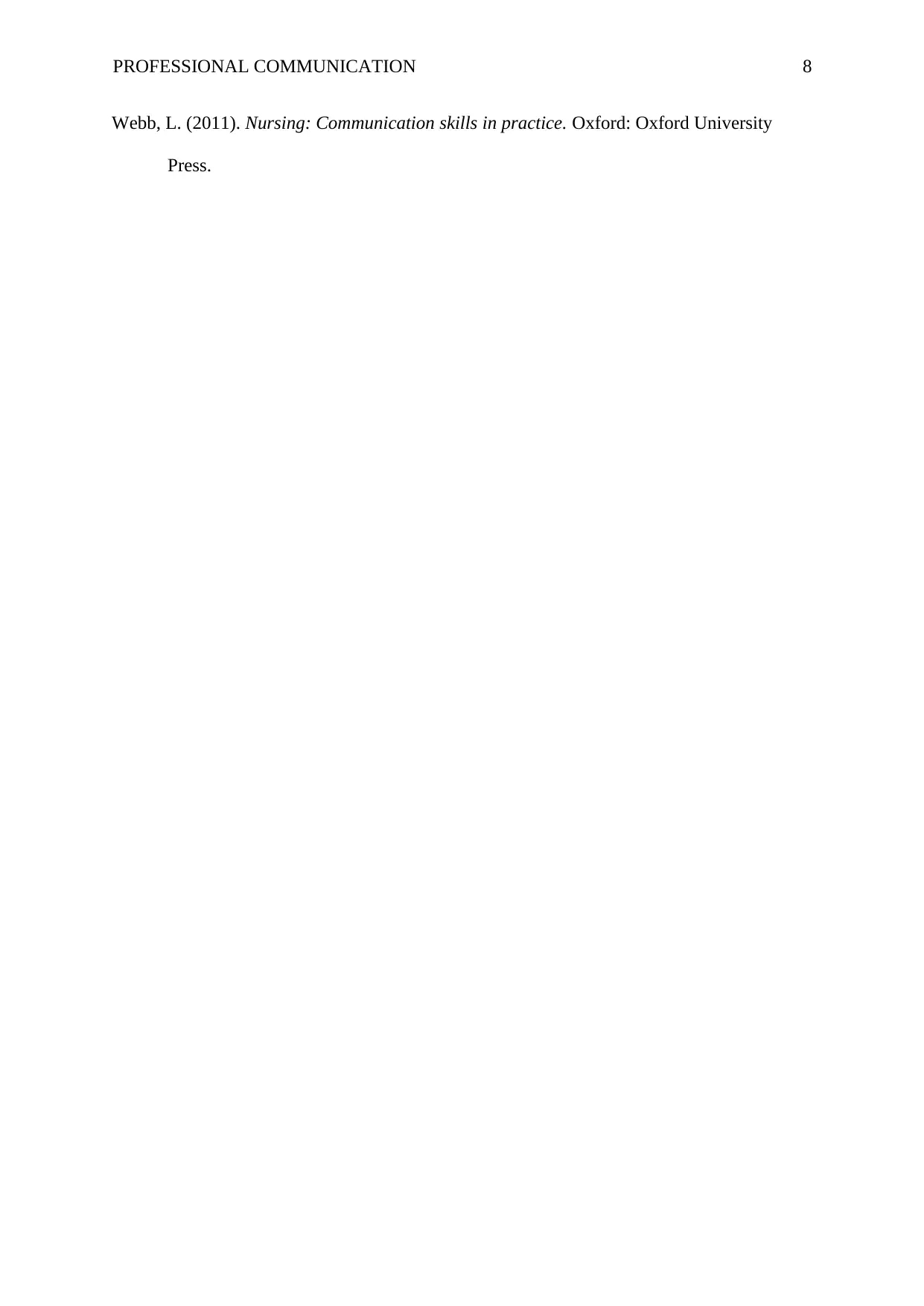
PROFESSIONAL COMMUNICATION 8
Webb, L. (2011). Nursing: Communication skills in practice. Oxford: Oxford University
Press.
Webb, L. (2011). Nursing: Communication skills in practice. Oxford: Oxford University
Press.
1 out of 8
Related Documents
Your All-in-One AI-Powered Toolkit for Academic Success.
+13062052269
info@desklib.com
Available 24*7 on WhatsApp / Email
![[object Object]](/_next/static/media/star-bottom.7253800d.svg)
Unlock your academic potential
Copyright © 2020–2025 A2Z Services. All Rights Reserved. Developed and managed by ZUCOL.





